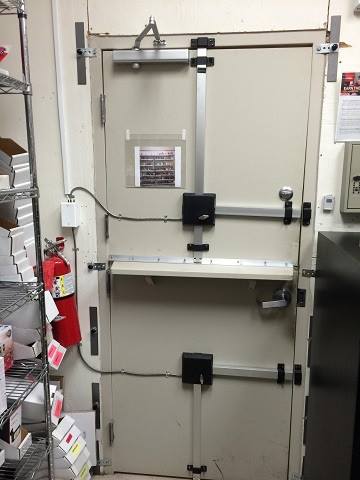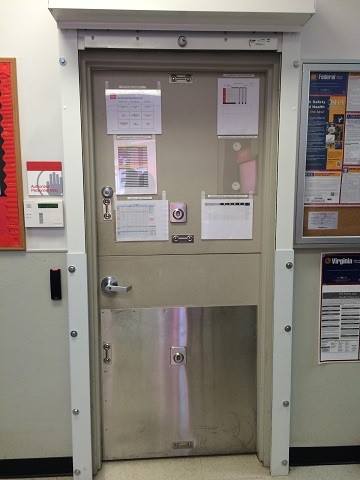Most egress doors are required to be readily openable with no special knowledge or effort. The door must unlatch with one operation, and the operable hardware must be mounted between 34 inches and 48 inches above the floor. There are several problems with this Wordless Wednesday dutch door found at a cell phone store:
Posted by Richard Minfield on the Truck Floor Training Facebook page, and shared here with permission.
You need to login or register to bookmark/favorite this content.







Looks like a door to their high value storage area??
I was going to say if it is a storage room door they can do what they want. But, not finding code to back that.
Still looks like the only way in and out of the room. So I like the 7-11 rule. If that is the only door into the 7-11, then for them to make money the door has to be unlocked.
Hi Charles –
For anyone just tuning in, the “7-11 Rule” would be the code section that allows some doors to have double-cylinder deadbolts. The idea is that in order for the 7-11 to be open and operating, the deadbolt has to be unlocked to allow people to enter, therefore it would also allow people to exit. Here is a portion of section 1010.1.9.3 from the 2015 IBC:
In buildings in occupancy Group A having an occupant load of 300 or less, Groups B, F, M and S, and in places of religious worship, the main door or doors are permitted to be equipped with key-operated locking devices from the egress side provided:
2.1. The locking device is readily distinguishable as locked.
2.2. A readily visible durable sign is posted on the egress side on or adjacent to the door stating: THIS DOOR TO REMAIN UNLOCKED WHEN THIS SPACE IS
OCCUPIED. The sign shall be in letters 1 inch (25 mm) high on a contrasting background.
2.3. The use of the key-operated locking device is revokable by the building official for due cause.
There was a change made to the 2015 edition – the word “exterior” was removed so this section could now be applied to the main door even if it is not exterior (like the main entrance of a store within a mall). But I wouldn’t apply this section to the cell phone store door unless this door is the main entrance – or I had permission from the AHJ. The lock also needs to be readily distinguishable as locked (the lock in the photo is debatable), and they would need signage.
– Lori
The door also requires 4 operations to unlatch it, and it doesn’t look like all of the operable hardware is between 34″ and 48″ AFF, and I think there might be some tight grasping, tight pinching, twisting, special knowledge and effort required.
– Lori
My guess would be, it’s a door access in a hospital to a pharmacist drug storage.
It’s in a cell phone store, but let’s say it was in a drug storage room. If I’m the person in the drug storage room, I still need to be able to unlatch the door with one operation, with no tight grasping, tight pinching, or twisting of the wrist, and no special knowledge or effort. And the hardware to release the latch has to between 34″ and 48″ AFF. There isn’t an exception in the codes for areas with a low occupant load, like a storage room or mechanical room.
– Lori
I was hoping this wasn’t a classroom door when I saw it….
There’s a coiling door in front of it too!
They really over killed this door :).
I wonder if it’s even a fire shutter, to make the opening even more fire resistant. >.<
To me, If you are already in the room unless you lock yourself in the room or someone on the outside locks you in,,
The door handle should be the only thing needed to open the door. Not sure if it is at the correct height.
With all the wiring going to the door it might be tied into the Fire Alarm Panel and would automatically unlock upon a fire signal.
Did you notice the mounting / reinforcing plate between the frame and wall – Yikes!!
Is that the Sprint store in Dublin? I think I”ve been there.
Check out the extra frame ‘anchors’ in the left picture on the frame face near the top miters and at the base of each jamb leg. Is that to prevent someone from kicking-in the entire door and frame assembly?
The door hardware arrangement is clearly illegal.
Since this inside the store and is to the product storage room, their problem appears to be employee theft or “shrinkage” Theirs is a management problem, i.e. they can’t trust their associates, not a problem that can be solved with any amount of security hardware.
I recommend that they fire all employees and start over with people they can trust. This is clearly a case where they have lost perspective on their problem.
I hope they remembered to install the security mesh behind the drywall, otherwise they wasted a lot on money on that door. 8) It does make you wonder how the wall is constructed.
We just got a call from a Cell Phone store a little while ago, where somebody broke into the storage room and stole all of the iphones and ipads in under 3 minutes. They got in and out with $70,000 dollars worth of merchandise. Evidently, cell phone theft is a big deal these days.
We were asked to provide a new security opening. Needless to say, our code-compliant solution did not look like this insanity.
Looks like custom made Securitech MP Police Lock multi-point locking systems with either door status indicator or bolt monitor switches. That is some super secure hardware that I would estimate costing about $2,000.00 list exclusive of the lever and deadbolt!
Pete Schifferli
Only missing the force field and magnetic holders at 16″ o.c. around the perimeter of the frame.
Actually, the vertical and horizontal bolts are all electrically operated, and only have thumbturns as a backup. The problems with this door include the cylinder deadbolt and the rolling shutter. I’m sure that operationally they only close the rolling shutter when the business is closed and after checking for occupancy. Basically, this door meets code except for the cylinder deadbolt, doesn’t it?
That’s a good question. Let’s look at the 7 electrified lock code sections that might be used on this door and see if it complies…
Delayed Egress – n/a – this is not a delayed egress lock
Controlled Egress – n/a – controlled egress is only allowed in health care
Stairwell Reentry – n/a
Elevator Lobby Egress – n/a
Access Controlled Egress Door (now called Sensor Release of Electrically Locked Egress Doors in the 2015 IBC) – no, even if the door does unlock on fire alarm and power failure, there is no sensor or push button
Electromagnetically Locked Egress Doors – this is not a mag-lock, but in addition, the lock is not released by door-mounted hardware that has an obvious method of operation that is readily operated with one hand under all lighting conditions, and I don’t know if the lock unlocks upon power failure
Controlled Access / Free Egress – no, because of the multiple operations required to unlock the door, the key/tool/special knowledge/effort, the mounting heights, the tight grasping/tight pinching/twisting of the wrist
IMO, it’s not code-compliant, even if the fire alarm retracts the bolts.
– Lori
The more I look, the more confused I get.
With the shelf on the PULL side, I don’t see how it can still function as a dutch door. There should be an overlapping astragal on the top leaf that pulls the bottom leaf closed along with it. (they don’t appear to be spring hinges on the bottom. I could be wrong about that)
And I guess it’s possible that activation of the electric strike would release all of the other contraptions at the same time…but that doesn’t explain the manual deadbolt on the top leaf.
The irony is that the building inspector checks the fire extinguisher every year and pays no attention to the mess that’s right next to it
Here’s the thing. All these surface mounted deadbolts are electrically operated by a single turn of the door handle, so no special knowledge is required. The surface mounted electrified deadbolts are rated for fire exit doors. The only thing I see out of compliance on this door is the single cylinder thumb operated deadbolt in the door itself.
Which door handle unlocks the bolts? Wouldn’t you have to retract the top bolt, the bottom bolt, the deadbolt, and the latch on the lever lockset separately? That would be 4 operations, some of which require tight grasping, tight pinching, and twisting of the wrist.
How about the gap at the top of the top leaf, this whole opening is a nightmare!!
Lori: Typically for this hardware, the 4 lever electrically operated deadbolts are electrically retracted and mechanically engaged. The deadbolts can be retracted electrically one of two ways 1) using a card reader, or using a switch inside the door handle . In this case, it appears that they are using a card reader on the outside of the door to retract the deadbolts.
In most cases, the deadbolts must be re-engaged one of three ways: 1)using the thumb-turns on the black boxes controlling the lever action deadbolts when the room is occupied or, 2)or they can be re-engaged by a key inserted into the stainless steel actions visible on the front of the door, or 3)the deadbolts can be configured to engage automatically.
It appears that this door is unlocked using a card reader and locked using the actions on the front of the top and bottom leaves of the door. There should also be a switch in the door handle so that when it is turned, the deadbolts retract in the off chance that someone inside the room has engaged the deadbolts manually.
The lonely little single-cylinder deadbolt on the upper leaf should not be there, so it is clear that this equipment is a retrofit. It should have been removed and blanked.
I doubt that the door can be fire rated due to the penetrations through the door. This door is almost certainly enclosing a high-value storage room where their cell phone inventory is stored, so it does not need to be fire rated.
Without the electric elements, this lock does not meet exit code and can only be used on unoccupied rooms such as weapons lockers, storage rooms, etc. With electrification, a variance can be obtained from the AHJ, allowing it to be used on an occupied room. It is clear to me that this lock was not installed under a variance because of the remaining legacy single-cylinder deadbolt.
I hope this helps.
Hi Thomas –
Can you tell me which code section allows unoccupied rooms to be locked in this manner?
– Lori
Ok so where does a bank vault fall?
If this is only a small storage room, that I have to unlock from the store side, about the only problem I see is if someone comes along and locks it up while I am in it.
Even then I can still get out. Just requires a few more steps.
I don’t see anything in the IBC about bank vaults, and there isn’t an exception to the unlatching requirements that would exempt storage rooms.
1008.1.9.5 Unlatching. The unlatching of any door or leaf shall not require more than one operation.
Exceptions:
1. Places of detention or restraint.
2. Where manually operated bolt locks are permitted by Section 1008.1.9.4.
3. Doors with automatic flush bolts as permitted by Section 1008.1.9.3, Exception 3.
4. Doors from individual dwelling units and sleeping units of Group R occupancies as permitted by Section 1008.1.9.3, Exception 4.
The rolling door could serve as the door
1008.1.2 Door swing. Egress doors shall be of the pivoted or side-hinged swinging type.
Exceptions:
1. Private garages, office areas, factory and storage areas with an occupant load of 10 or less.
1008.1.4.4 Security grilles. In Groups B, F, M and S, horizontal sliding or vertical security grilles are permitted at the main exit and shall be openable from the inside without the use of a key or special knowledge or effort during periods that the space is occupied. The grilles shall remain secured in the full-open position during the period of occupancy by the general public. Where two or more means of egress are required, not more than one-half of the exits or exit access doorways shall be equipped with horizontal sliding or vertical security grilles.
1008.1.2 Door swing. Egress doors shall be of the pivoted or side-hinged swinging type.
Exceptions:
1. Private garages, office areas, factory and storage areas with an occupant load of 10 or less.
Lori, I will have to check with the Manufacturer, Securitech. This is a variation on their Police Lock, which is designed for evidence rooms, etc. I’ll try to give them a call today if I have time.
I don’t believe these Securitech style locks are electrically retractable .. The wiring is to for a sensor in the lock to indicate if it is unlocked or forced to the open position which is attached to the alarm system.
So you have 4 operations to unlock this door..
Major frame issues
Major wall issues
Kick plate is more than 16 inches probably not factory installed ..
Non rated wood counter attached to door
I know this is pretty late in the game (also I bet someone pry already mentioned this). Why not use a multi-point lock with a high-security cylinder. Then one lever retracts 3 latch bolts. Also, its called a security camera on the inside. this looks like a doomsday preppers dream. Not worried about getting out once youve locked yourself in. haha
I think everyone is missing how this door operates. No one goes inside and locks themselves in. They unlock the roll door, then unlock the security door. They then enter, absent an attempt at theft the top of the door is left open, and the bottom can be opened by turning the handle on the inside. You don’t lock an employee in there.
There is nothing on this door to suggest it’s an emergency exit at least I don’t see the signage . If the room in question is in fact a storage room this door would have been more secure if it had opened outward. The door stops would have added additional strength from a kick in attempt and saved thousands in Hardware cost . Allowing for a simple alarm contact and security hardware ie. A dead bolt .